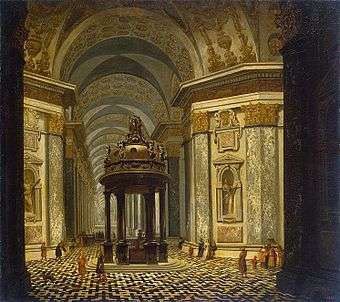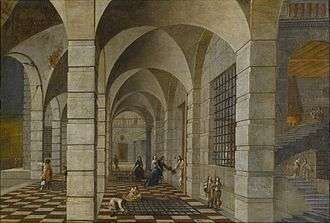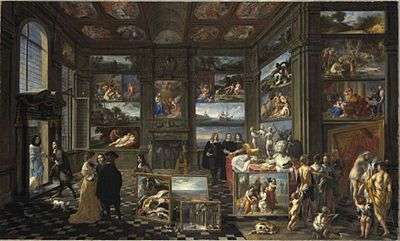Wilhelm Schubert van Ehrenberg
Wilhelm Schubert van Ehrenberg or Willem Schubart van Ehrenberg (also: Wilhem Schubert von Ehrenberg or Wilhem Schubert van Ehrenberg (Antwerp, 1630 or 1637– Antwerp, c. 1676) was a Flemish painter mainly active in Antwerp who specialized in architectural paintings including of real and imaginary church interiors, Renaissance palaces and picture galleries.[1][2]

Life
Most likely born in Antwerp where his baptism is recorded on 12 May 1630 (despite an unnamed source stating he was born in Germany), he entered the Antwerp Guild of Saint Luke in 1662. He resided in Antwerp for most of his life.[2] It is possible he travelled to Italy as he made drawings of Italian subjects.[3]
The date of his death is not known with certainty and is believed to have occurred between 1687 (the latest date of one of his dated works) and 1707.[2]
He was the teacher of the painter of architecture paintings Jacobus Ferdinandus Saey.[2]
His son Peter Schubart von Ehrenberg was also an artist who had a successful career as a painter, engraver and stage designer in Vienna.
Work
General
The majority of van Ehrenberg's pictures were painted between 1660 and 1670. He often collaborated with other artists who added the figures or animals.[3] This was a common practice in 17th century Antwerp. His collaborators included Hendrik van Minderhout, Gaspar de Witte, Hieronymus Janssens and Charles Emmanuel Biset.
Architectural works

Van Ehrenberg painted many architectural paintings usually of imaginary church interiors, temples, palaces and art galleries. Paintings such as the Interior of the Saint-Carolus-Borromeus Church in Antwerp (1667; Royal Museums of Fine Arts of Belgium, Brussels)[4] emphasize the Baroque architecture of the space depicted, but are more artificial than his Dutch Golden Age contemporaries such as Pieter Jansz Saenredam or Emanuel de Witte.[1] His Interior of the St. Peters' Church in Rome stands in the tradition of Antwerp architecture art from the first half of the 17th century. However, the spatial effect in the oeuvre of van Ehrenberg is stronger. He showed a particular preference for the fantastic and pathetic, which he emphasized further with light-dark contrasts and a staffage of almost dwarfish figures (often painted by other artists).[5]
Of particular interest are a set of paintings representing the Seven Wonders of the World such as the Mausoleum of Halicarnassus and The Temple of Diana at Ephesus (both in the Musée Henri Dupuis Saint-Omer) and the two paintings of ruined tombstones (both in Oxford College Anon II, University of Oxford).
Gallery paintings
Wilhelm Schubert van Ehrenberg worked also in the genre of the 'gallery paintings'. The 'gallery paintings' genre is native to Antwerp where Frans Francken the Younger and Jan Brueghel the Elder were the first artists to create paintings of art and curiosity collections in the 1620s.[6] Gallery paintings depict large rooms in which many paintings and other precious items are displayed in elegant surroundings. The earliest works in this genre depicted art objects together with other items such as scientific instruments or peculiar natural specimens. The genre became immediately quite popular and was followed by other artists such as Jan Brueghel the Younger, Cornelis de Baellieur, Hans Jordaens, David Teniers the Younger, Gillis van Tilborch and Hieronymus Janssens. The art galleries depicted were either real galleries or imaginary galleries, sometimes with allegorical figures.[7]

An example of van Ehrenberg's work in this genre is the Interior of an art collector's cabinet with many visitors (Musée Girodet, Montargis). This is a collaboration with Gaspar de Witte and Hieronymus Janssens. The composition depicts an imaginary art gallery with many visitors who are appreciating and discussing some of the artworks in the gallery. This gallery painting represents a later development in the genre initiated by David Teniers the Younger, which excludes non-art objects from the gallery. The figures in the gallery painting are portrayed as forming part of an elite who possess privileged knowledge of art. The genre of gallery paintings had by that time become a medium to accentuate the notion that the powers of discernment associated with connoisseurship are socially superior to or more desirable than other forms of knowing.[7]
The Interior of an Imaginary Picture Gallery (Alte Pinakothek, Munich) dated to 1666 falls into the category of allegorical picture galleries, which can be considered a sub-category of the imaginary art gallery type. This composition depicts a large imaginary gallery in which are present a number of persons admiring and scrutinizing artworks and, on the right hand side, figures representing gods and allegorical figures. The painting is a collaboration with each of the individual painters whose work is depicted in the painting and have signed their own work: Theodoor Boeyermans (Daughters of Cecrops and Erychtonius), Pieter Boel (Animal Piece), Jan Cossiers (Diana and Actaeon), Cornelis de Heem (Fruit Still Life), Robert van den Hoecke (Winter Landscape), Philips Augustijn Immenraet (Italianate Landscape), Jacob Jordaens (Gyges and Kandaules and Allegory of Painting), Pieter Thijs (Adoration of the Shepherds), Lucas van Uden (Landscape) and the monogrammists missed PB (Fish Still Life) and PVI or PVH (Satyr and Nymph). Van Ehrenberg painted the architecture as well as the ceiling (which is made up of copies of Rubens’ works for the Carolus Borromeuskerk in Antwerp) (later destroyed in a fire). The figures are probably by Charles Emmanuel Biset.[8] Other such collaborations between multiple Antwerp painters on picture gallery paintings are recorded. Another example is Jacob de Formentrou’s Cabinet of pictures (also known as Art lovers in a painting cabinet), part of the collection of the Royal Collection.[9] Such paintings can be read as a reference to connoisseurship, and in particular the connoisseur's activity of evaluating the authorship of paintings based on stylistic characteristics.[10] It can also be regarded as a carefully crafted advertisement of the present talent and past legacy of the Antwerp school of painting.[11]
Notes
- Hans Vlieghe (1998). Flemish Art and Architecture, 1585-1700. Pelican history of art. New Haven: Yale University Press. p. 201. ISBN 0-300-07038-1.
- Wilhelm Schubert van Ehrenberg at the Netherlands Institute for Art History (in Dutch)
- Biographical details on the site of the J. Paul Getty Museum
- Interior of the Saint-Carolus-Borromeus Church in Antwerp
- Interior of the St. Peters' Church in Rome at vlaamsekunstcollectie]] (in Dutch)
- Susan Merriam, Seventeenth Century Flemish Garland Paintings. Still Life, Vision and the Devotional Image, Ashgate Publishing, Ltd., 2012
- Marr, Alexander (2010) 'The Flemish 'Pictures of Collections' Genre: An Overview', Intellectual History Review, 20: 1, 5 — 25
- Interior of an Imaginary Picture Gallery at the Netherlands Institute for Art History (in Dutch)
- Jacob de Formentrou (fl.164059), A cabinet of pictures, at the Royal Collection
- Hannelore Magnus, 'Schilders, connoisseurs en hun (Salomons)oordeel, Het Schilderijenkabinet (1659) van Jacob de Formentrou en Erasmus II Quellinus' (in Dutch)
- Nadia Sera Baadj, Monstrous creatures and diverse strange things”: The Curious Art of Jan van Kessel the Elder (16261679), A dissertation submitted in partial fulfillment of the requirements for the degree of Doctor of Philosophy (History of Art) in The University of Michigan, 2012
| Wikimedia Commons has media related to Wilhelm Schubert van Ehrenberg. |